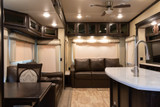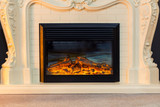RecPro Travel Blog and Tips: Traveling the Great Smoky Mountains
Pigeon Forge, Tennessee. It’s the land of Dolly Parton, Cade’s Cove, Vegas-level roadside attractions, and many RV parks that rival the secluded mountain cabins that conspicuously dot the hillsides. As you’re traveling down the main strip through town and you see gigantic sharks and “gem mines” pawing at you for your tourist dollars, you may find that you want to get away from the hustle and bustle and escape to the mountains. Of course, you do, “There’s scenery up in them thar hills!”
If you’re driving a passenger car or an SUV, these trips can be simple enough as long as you are careful and follow all of the applicable rules of the road. We had a pretty easy time navigating the tight curves and steep grades of the Smokies (especially going up into the State Park to see Cade’s Cove.) The scenery is beautiful in Tennessee, and the people there are the salt-of-the-earth mountain folks you’d expect them to be. One thing that we saw a lot of, that I didn’t expect, were RVs on the side of the road.While a few were going down the mountains, most were facing toward the top. We stopped to see if people needed help and we consistently found three problems:
- Overheating engines or transmissions
- Overheating brakes
- Connection issues with haulers
We helped as much as we could, but we saw what these folks needed more than help was information. If you’re new to the RV life, or you don’t travel the difficult parts of the country that much, there are things you need to know before you go off to Colorado and Northern Idaho.
Question: Should you get a “running start” before heading up the hill?
Answer: The simple answer is, no. Your engine has a sweet spot known as the “power band.” This is where the RPMs are going to give you maximum, steady, output for the drive ahead. You will have to research the vehicle and even do your road testing to find that perfect place where you’re getting the best performance and not putting too much stress on your engine (which can cause it to overheat and even blow out.)RVs and trucks can come with a “tow-haul” mode that will assist with proper shifting on steep grades. If your vehicle is equipped with this function, it’s good to utilize if you’re unsure of your ability to drive through the mountains.
Question: How should your trailer/fifth-wheel be hooked-up for a trip through the mountains?
Answer: This is purely a safety question. You should always make sure that your trailer is correctly hooked up to your hauler, as well as having all possible safety equipment installed/attached. A few items to make sure of:
1.Always triple check (yes, triple) that your coupler is securely attached to your hitch ball. Many times it seems like you’re firmly hitched, but the coupler is not correctly locked around the ball.
2.Make sure the coupler latch is down and secured with the latch pin. Latch pins can work their way out of their seating hole. It’s wise, any time you are stopped for any length, to check and make sure the pin is secure.
3.Make sure you have your safety chains securely attached. Again, an item that you should check at any stop. These can bounce out of their holes and drag on the ground. Also, make sure your chains are the proper length to travel. If they’re too long, they’ll drag and spark.
4.Attach and test the lighting. Make sure the brake lights, blinkers, and reverse lights all work correctly.
5.If you don’t have a sway control, it might be an excellent idea to install one on your unit. The forces that are put on your vehicle when you are going up, or down, a mountain are quite different than when you are traveling along a flat highway. A sway control can mean the difference between a smooth trip, or an out of control trailer.
Question: How should I brake going downhill?
Answer: Proceed with caution. You want to slow it way down before you start down any grade. Remember that if you have to travel at speeds of 30 mph, it may make your travels longer, but at least you’ll increase your chances of arriving alive. If you go too fast, you can overheat your brakes (making them ineffective), and it will be tough for your brakes to stop you if you are at higher speeds with inertia, not, on your side. It’s best to press your brakes at 15-20 second intervals, going slow, starting in a downshifted state.
Question: What are good standard practices when going up and down steep grades?
Answer: Here are a few things to do that can help you increase visibility and travel safely:
1.Always, whether going up or down steep grades, use your hazard lights. It doesn’t matter if it’s at night, or during the day, you want to be as visible as possible to your fellow travelers. Helping them see you, so they have time to react to your slower speeds will keep everybody safer.
2.Downshifting is critical no matter which direction you’re traveling. You want to keep it slow and steady up and down the mountain.
3.Make sure any loose items that can slide toward the cockpit of your RV are stowed away or tied down. Some grades can be pretty dangerous (Colorado, Northern Idaho, etc.) around the country and the last thing you need is something hitting you in the back, or slamming into the rear of your RV.
A little precaution can go a long way when you’re traveling around the country. Your RV isn’t like a typical vehicle, so you need to take extra steps to ensure that you and those around you arrive safely at your destinations. If you follow these simple rules, you’ll be traveling with ease through the peaks and valleys of these beautiful United States.
Recent Posts
-
4 Tips for Securing RV Furniture While Traveling | RecPro
How To Secure RV Furniture There are few things that beat going out on an adventure with an RV …Apr 11th 2024 -
Can You Put Regular Furniture in an RV?
Can you put regular furniture in an RV? Many new and old RV owners ask themselves this qu …Apr 8th 2024 -
Are RV Electric Fireplaces Safe
Being Safe in Your RV with an Electric Fireplace Safety is always going to be one of your highest …Apr 4th 2024 -
How To Install An RV Fireplace
A Warm Addition to Your On-Wheels: The DIY RV Fireplace Installation Guide Many RV enthusiasts ask …Apr 1st 2024 -
Essential Grilling Gear Every RVer Needs
Whether or not you consider yourself a pitmaster or grillmaster, if you’re out on the road with y …Mar 18th 2024 -
Fun and Interesting Places to Visit That Aren’t a National Park
One of the big destinations when RVing is to go to National Parks. You want to get back to nature, h …Mar 4th 2024







